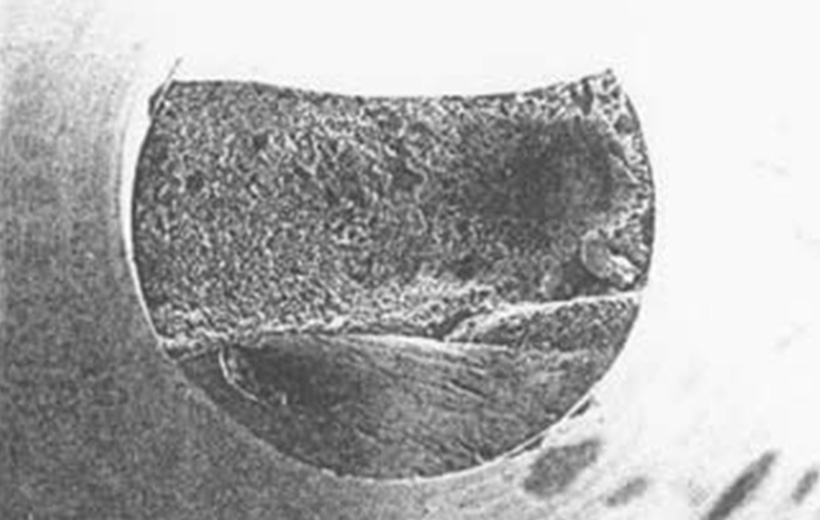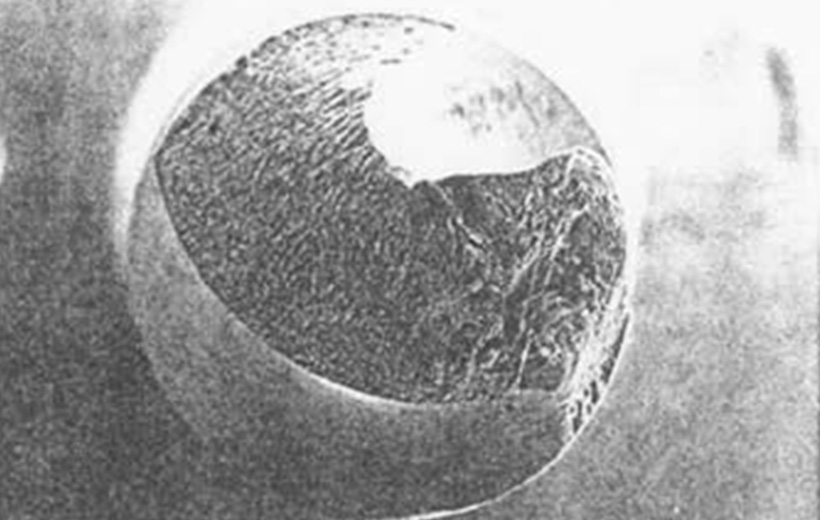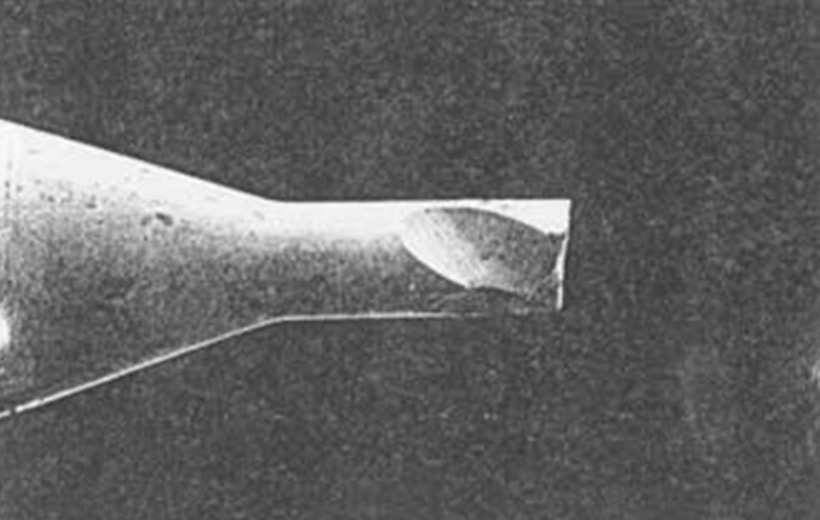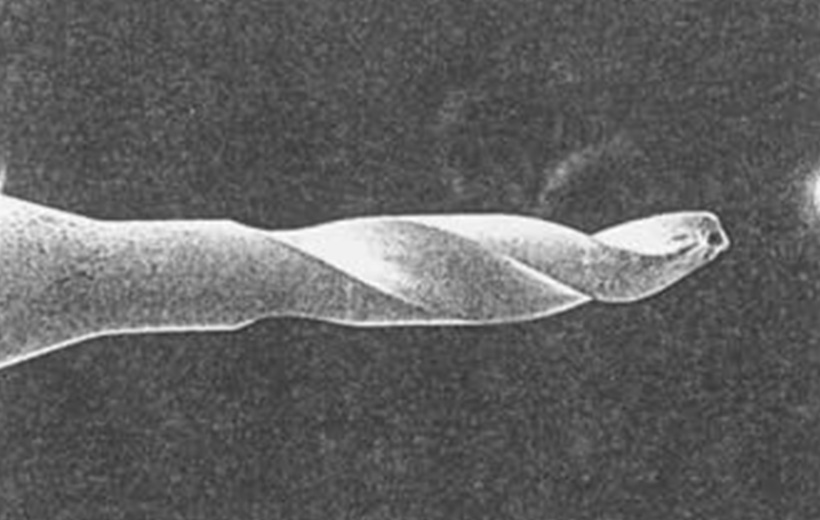There are mostly two reasons why a drill breaks. Deflected breakage is caused by the radial force, the drill bit is broken at the end of flute. Twisted breakage is caused by the large torque, the drill bit is normally broken at the middle of the flute.



Bent Breakage

Twisted Breakage
| Cause | Failure condition | Countermeasure |
|---|---|---|
| Poor drill bit strength | Large deflection causes drill bit to break at the end of the flute. | To increase strength, change web thickness and web taper. Use the drill bit for superior hole registration accuracy. |
| Small chip pocket (Flute volume) | Increased twisted moment/load causes breakage with breakage point in the middle of flute. | Enlarge chip pocket volume, change web thickness, web taper, and flute land ratio. |
| Long flute length and body length | When flute length and body length are unnecessarily long, the hole registration accuracy worsens. | Set suitable flute length and body length. |
| Unsuitable tungsten carbide material | Low Transverse Rupture Strength (TRS) causes drill breakage more easily through cutting resistance. | Use wear-resistant WC material. |
| Cause | Failure condition | Countermeasure |
|---|---|---|
| Unbalanced drill point geometries (Chisel point excentricity, Lip height gap, Chipping, and one sided taper or flare, etc.) | Hole registration accuracy worsens with asymmetrical drill bits. (inconcentricity, chisel point, Lip height gap, chipping) | Check drill point geometry. |
| Excessive diameter wearing of repointed drill bits | Outside taper forms front taper shape. The cutting resistance increases and it breakage occurs. | Remove large worn part of drill by improved repointing. |
| Cause | Failure condition | Countermeasure |
|---|---|---|
| High chipload | Hole registration accuracy worsens by swarf clogging and chipped drill bit, causing breakage. Thrust load is also increased. | Apply suitable chipload. (Please refer to drilling parameters.) |
| Low chipload | Progressive wearing worsens hole registration accuracy, resulting in breakage problems. | |
| Low spindle speed | Increased frictional heat causes breakage. | Apply suitable spindle speed. (Please refer to drilling parameters.) |
| High spindle speed | The bit is broken by cutting load with increased cutting resistance (moment load). | |
| Material deposit at drill point (PCB's copper) | The bit deflects at the upper surface of entry board causes breakage. | Consider suitable drilling conditions. Using short chisel line (small web thickness) drill bit. Use large chip pocket drill bit. |
| Unsuitable pec drilling | The increment of steps doesn't match PCB stack height, which causes swarf clogging and breakage. | Recalculate pec drilling step increments/parameters |
| Penetrating to deep into the backup board | Materials such as backup board generate large particles of swarf which can adhere to the drill causing breakage | Apply suitable penetration depth. |
| Cause | Failure condition | Countermeasure |
|---|---|---|
| Panel stack height to high | Hole registration accuracy worsens through swarf clogging, causing bit breakage. Thrust load is also increased. | Apply suitable PCB stack heights to achieve the quality target. |
| High number and thickness of PCB copper layers | The bit wears more quickly, generating increased cutting load and breakage | Decrease PCB stack heights and hit count to reduce drill bit damage. Use double drilling method. |
| Hard cutting PCB material | As a result of increased tool load, the bit is broken by wearing and possible deflection | Decrease PCB stack heights and hit count to reduce drill bit damage. |
| Unsuitable entry board | In a thicker PCB's, the bit is broken by cutting resistance. | Consider suitable PCB thickness. |
| Scratching and dust on the front side of entry board | Unevenness of entry board causing deflection and breakage. | Control the management and handling of entry board. Check the bush for defects |
| Unsuitable backup board | Hard backup board generates wearing and increased cutting resistance, causing breakage. | Consider suitable hardness. |
| Unsuitable Stack preparation | Poor stack preparation causes loose entry board to flap and the PCB's have poor rigidity causing deflection and breakage | Check stud pins and taping of the PCB stacking to prevent the entry board flapping and gaps in PCB stack. |
| Uneven and scratched surface on the PCB | Unevenness and scratches on the front side of the entry board, can cause the drill to deflect and break. | Check PCB quality. |
| PCB qualities | Uneven resin and fiber intersections worsen hole registration accuracy and causes breakage. | Check PCB quality. Example: Check unevenness of PCB using an image processor/AOI machine for measuring hole registration accuracy. ---> An extreme striped pattern, etc. |
| Cause | Failure condition | Countermeasure |
|---|---|---|
| TIR (Total Indicated Runout) | Large dynamic deflection worsens accuracy, and causes breakage. | Control spindle run out (maintenance and repair). Recommended value <10 micron (<5 micron is better for <0.3mm drill bits) |
| Poor drill chucking (Dust in spindle chuck, spindle chuck wearing, scratching, marking for identification, etc.) | Increased dynamic deflection by poor chucking causes breakage. | Maintain collet chuck. |
| Uneven contact of bush with entry board | Uneven bush contact, a damaged bush or poor surface condition of the bush contact area causes breakage. | Check whether pressure foot is parallel with the machine table. Check bush contact using PV-Checker. (Recommendation: Over 80% surface touching bush) |
PRODUCT 01 PCB Drills / Routers / Ultra precision micro-hole drill